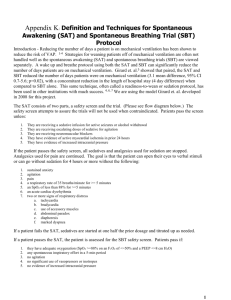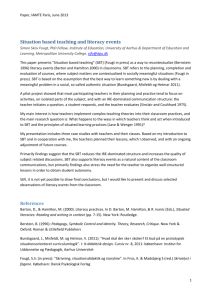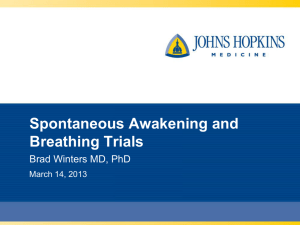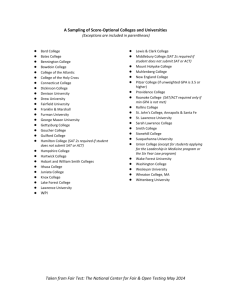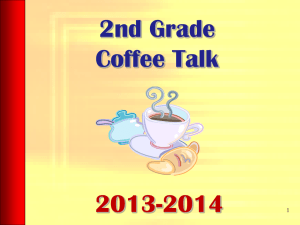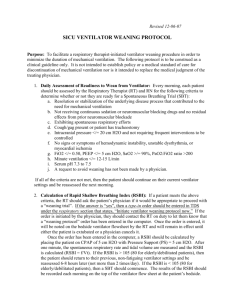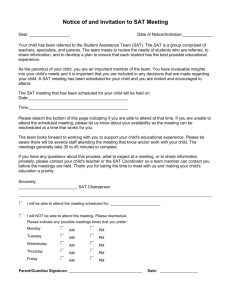Clinical Protocol - community360.net
advertisement
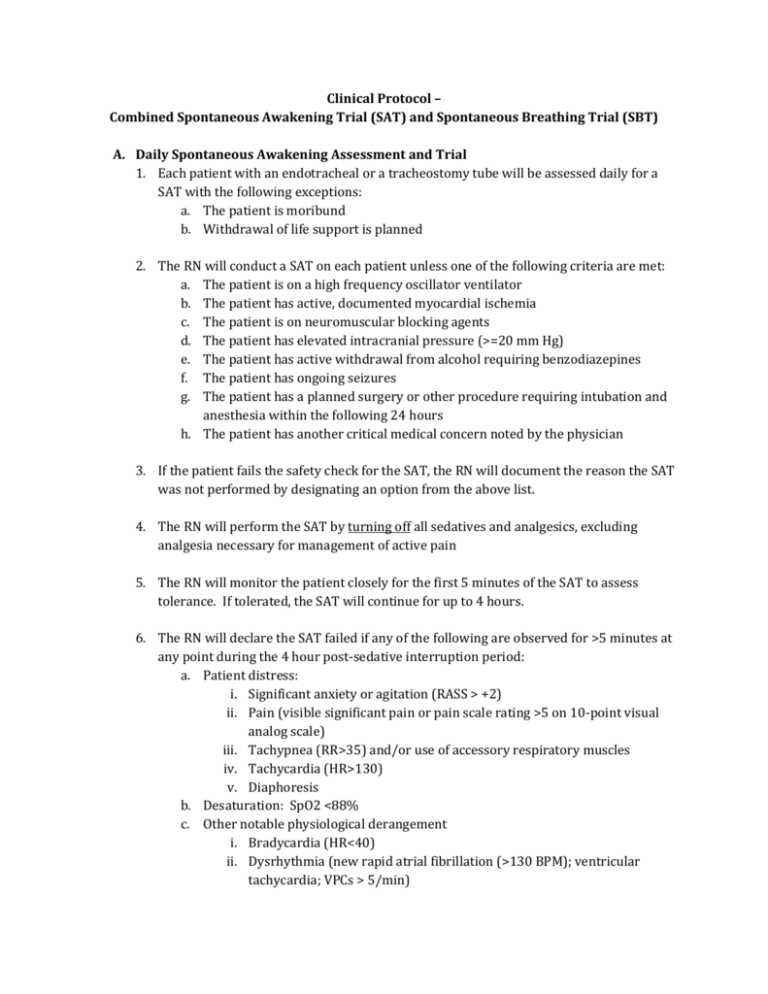
Clinical Protocol – Combined Spontaneous Awakening Trial (SAT) and Spontaneous Breathing Trial (SBT) A. Daily Spontaneous Awakening Assessment and Trial 1. Each patient with an endotracheal or a tracheostomy tube will be assessed daily for a SAT with the following exceptions: a. The patient is moribund b. Withdrawal of life support is planned 2. The RN will conduct a SAT on each patient unless one of the following criteria are met: a. The patient is on a high frequency oscillator ventilator b. The patient has active, documented myocardial ischemia c. The patient is on neuromuscular blocking agents d. The patient has elevated intracranial pressure (>=20 mm Hg) e. The patient has active withdrawal from alcohol requiring benzodiazepines f. The patient has ongoing seizures g. The patient has a planned surgery or other procedure requiring intubation and anesthesia within the following 24 hours h. The patient has another critical medical concern noted by the physician 3. If the patient fails the safety check for the SAT, the RN will document the reason the SAT was not performed by designating an option from the above list. 4. The RN will perform the SAT by turning off all sedatives and analgesics, excluding analgesia necessary for management of active pain 5. The RN will monitor the patient closely for the first 5 minutes of the SAT to assess tolerance. If tolerated, the SAT will continue for up to 4 hours. 6. The RN will declare the SAT failed if any of the following are observed for >5 minutes at any point during the 4 hour post-sedative interruption period: a. Patient distress: i. Significant anxiety or agitation (RASS > +2) ii. Pain (visible significant pain or pain scale rating >5 on 10-point visual analog scale) iii. Tachypnea (RR>35) and/or use of accessory respiratory muscles iv. Tachycardia (HR>130) v. Diaphoresis b. Desaturation: SpO2 <88% c. Other notable physiological derangement i. Bradycardia (HR<40) ii. Dysrhythmia (new rapid atrial fibrillation (>130 BPM); ventricular tachycardia; VPCs > 5/min) 7. The RN will declare the SAT passed if the patient can open eyes to voice and follow simple commands (e.g., squeezing fingers, blinking eyes) at the time of assessment or within 4 after the interruption of sedation. 8. If the patient FAILS the SAT, the RN will be place the patient on the same sedative at one-half the dose prior to beginning the SAT. The SBT will not be performed that day. 9. If the patient PASSES the SAT, the RN will inform the RT. B. Daily Spontaneous Breathing Assessment and Trial (SBT) 1. The RT will assess each patient with an endotracheal or tracheostomy tube daily to determine readiness for removal from ventilator support. 2. The RT will conduct a SBT on patients who meet the following criteria: a. Fi02 ≤ 0.4 b. PEEP ≤ 8 3. The RT will not perform a SBT if any of the following criteria are met: a. FiO2 >0.40 b. SpO2 <88% for >5 minutes during the SAT c. No spontaneous respiratory effort for >5 minutes d. PEEP >8 cm H2O e. Significant vasopressor use (dopamine >5mcg/kg/min, norepinephrine >2mcg/min, any vasopressin use) f. Use of high frequency oscillating ventilator g. Use of neuromuscular blocking agents h. Active myocardial ischemia i. Increased intracranial pressure (≥20 mm Hg) j. Severe agitation (RASS > +2) If the SBT is not performed for one of the reasons above, the reason will be documented by designating an option from the above list. 4. The RT will be perform the SBT with low level of CPAP (5-8 cmH20) or PSV 5 with 5-8 cmH20 PEEP while maintaining the ventilator's Fi02. a. The head of the bed should be elevated to 30 degrees. 5. The RT will monitor the patient closely for the first five minutes of the SBT to assess tolerance. If tolerated, the SBT will continue for at least 30 minutes (and up to 120 minutes), unless a shorter duration is ordered by the physician. 6. The RT will declare the SBT as FAILED if any of the following signs or symptoms are observed for 5 or more minutes during the SBT: a. Patient distress: i. Significant anxiety or agitation (RASS > +2) ii. Pain (visible significant pain or pain scale rating >5 on 10-point visual analog scale) iii. Tachypnea (RR>35) and/or use of accessory respiratory muscles iv. Tachycardia (HR>130) v. Diaphoresis b. Desaturation: SpO2 <88% c. Other notable physiological derangement i. Bradycardia (HR<40) ii. Dysrhythmia (new atrial fibrillation; ventricular tachycardia; VPCs > 5/min) 7. The RT will declare the SBT as PASSED if SBT continues for at least 30 minutes 8. If a patient FAILS the SBT, the RT will place the patient back on the ventilator at the same settings as prior to the SBT 9. If the patient PASSES the SAT, the RT will inform the physician of the patient’s potential readiness for removal from ventilator support and extubation. 10. If the patient passes the SBT but the patient is not extubated, the RT will document the reason the extubation was not performed. 11. Extubations and post-extubation care will be provided according to the unit’s existing protocols and procedures.
